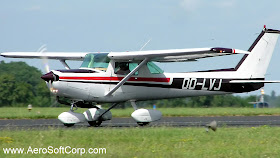www.AeroSoftCorp.com
One of the major general aviation aircraft manufacturing corporations, Cessna Aircraft Company is headquartered in Wichita, Kansas, USA.
The Cessna 152 is one of the smallest 4-cylinder engine, two seat, and general aviation airplane in use for flight training and personal use. The
reason is that the almost every pilot has fair flying experience on this and it the cheapest to hire.
The C152 was a modernization of Cessna 150 design and was first introduced in 1977. A total of 7,584 aircrafts were built, including A152 and
FA152 Aerobat aerobatic variants worldwide ending the production in 1985, when Cessna ended production of all of their light aircraft. All
Cessna 152s were manufactured with a Lycoming O-235 engine. The engine power of C152 is more than that of C150 and it was more compatible
with newer 100LL low lead fuel.
Earlier built Cessna 152s were equipped with Lycoming O-235-L2C engines producing 110 hp (82 kW) at 2550 rpm. This engine still suffered some
lead-fouling problems in service and was succeeded later by the 108 hp (81 kW) O-235-N2C which featured a different piston design and a redesigned
combustion chamber to reduce this problem. The N2C engine was used until 152 production ended in 1985.
Airframe
The 152's airframe primarily consisted of aluminium 2024-T3 alloy and some components like wing tips and fairings made from glass-reinforced plastic.
The fuselage is a semi-monocoque structure: it has vertical bulkheads and frames joined by longerons which run the length of the fuselage. The wings
are of a strut-braced design and have a 1 degree dihedral angle. The tapered (outboard) portion of each wing has one degree of washout which allows
greater aileron effectiveness during a stall.
Flying controls
The Cessna 152 is equipped with differential ailerons having a movement of 20 degrees upwards and 15 degrees downwards. It has single-slotted flaps
which are electrically operated and deploy to a maximum of 30 degrees. The rudder can move 23 degrees to either side and is fitted with a ground
adjustable trim tab. The elevators move up through 25 degrees and down through 18 degrees. An adjustable trim tab is installed on the right elevator
and is controlled by a small wheel in the center of the control console. The trim tab moves 10 degrees up and 20 degrees down relative to the elevator
chordline.
Undercarriage
The Cessna 152 is equipped with fixed tricycle landing gear. The nose wheel is connected to the engine mount and has an oleo strut to dampen and
absorb normal operating loads. It is connected to the rudder pedals through a spring linkage. The braking system consists of single disc brake assemblies
fitted to the main undercarriage and operated by a hydraulic system. Brakes are operated by pushing on the top portion of the rudder pedals. It is
possible to use differential braking when taxiing and this allows very tight turns to be made.
The 152 is also fitted with a parking brake system. It is applied by depressing both toe brakes and then pulling the "Park Brake" lever to the pilot’s left.
The toe brakes are then released but pressure is maintained in the system thereby leaving both brakes engaged.
Numerous modifications are available for the Cessna 152 like-
1. Tailwheel landing gear- It involves strengthening the fuselage and greatly improves short field performance and is claimed to give up to a 10 kn (19 km/h) cruise speed increase.
2. STOL kits- The wings can be modified using a number of STOL modification kits, some improving high speed/cruise performance but most concentrating on
STOL performance. It involves fitting a more cambered leading edge cuff to increase the maximum coefficient of lift, fitting fences at the aileron/flap
intersection and fitting drooped wingtips.
3. Engine - Engine's power can be increased by modifications, like the Sparrow Hawk power package, increasing it to 125 hp (93 kW).
4. Flap gap seals to reduce drag and increase rate of climb.
5. Different wing tips, some of which claim various cruise speed increases and stall speed reductions.
6. Auto fuel STCs, which permit the use of automobile fuel instead of the more expensive aviation fuel.
7. Auxiliary fuel tanks for greater range.
8. Door catches to replace the factory ones that often fail in service.
9. Belly fuel drain valves to drain fuel from the lowest point in the fuel system.
Specifications (Cessna 152)
General characteristics
• Crew: 1 pilot
• Capacity: 1 passenger
• Length: 24 ft 1 in (7.3 m)
• Wingspan: 33 ft 4 in (10.2 m)
• Height: 8 ft 6 in (2.6 m)
• Wing area: 160 ft² (14.9 m²)
• Empty weight: 1,081 lb (490 kg)
• Max. takeoff weight: 1,670 lb (757 kg)
• Powerplant: 1 × Lycoming O-235-L2C flat-4 engine, 110 hp (82 kW)
Performance
• Maximum speed: 126 mph (110 knots, 204 km/h)
• Cruise speed: 123 mph (107 knots, 198 km/h)
• Stall speed: 49 mph (43 knots, 79 km/h) unpowered, flaps down
• Range: 477 mi (414 nm, 768 km)
• Extended range 795 mi (690 nm, 1,280 km) with long-range tanks
• Service ceiling: 14,700 ft (4,480 m)
• Takeoff roll: 725 ft (221 m))
• Rate of climb: 715 ft/min (3.6 m/s)
• Max. wing loading: 10.44 lb/ft² (51 kg/m²)
• Minimum power/mass: .066 hp/lb (108 W/kg)
Foker 50 Friendship
Cessna 152
















No comments:
Post a Comment